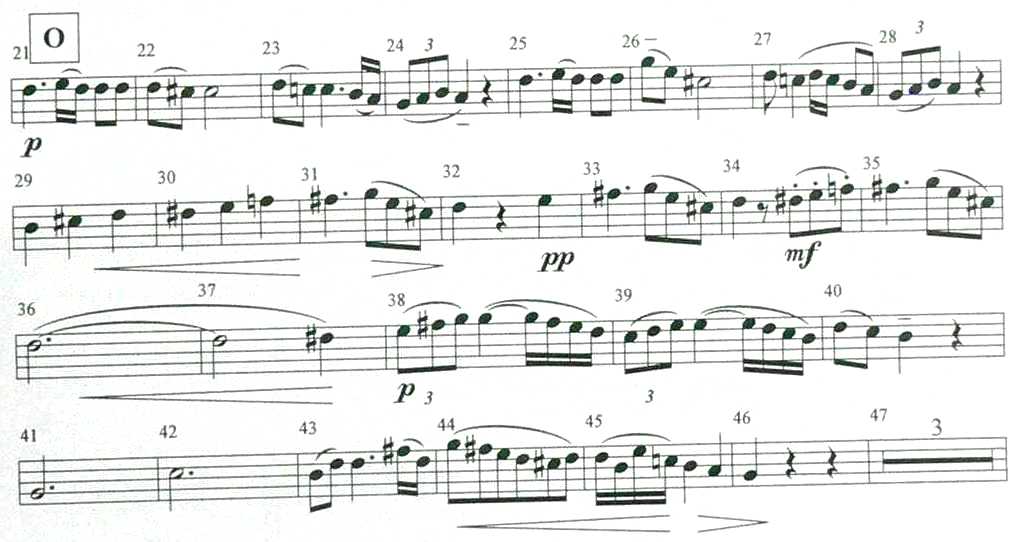|
3eme Concerto pour le Cor op.106 (K.495) |
Ein Waldhorn Konzert für den Leitgeb |
|
How to play this concert |
Interpretationsanleitung |
|
Mozart´s third Concerto for horn, which we named the No.4. Why ? The No.1 D-major is a fragment only, never finished by Mozart himself. |
Mozarts drittes Hornkonzert, das wir als no.4 bezeichnen. Warum ? No.1 in D-Dur ist ja nur ein Fragment, das Mozart nie fertiggestellt hat. |
|
2nd movement: |
ROMANZA Andante p.10 |
|
|
|
|
There is no need to use the Bb-side for the following phrase MM.21-37 except the use of it for the f2 (T1). Using the F-side would give the player the chance to use the best sound spectrum of the horn, as only the best sounding harmonics will be involved here. More than that: the intonation would be much better using the F-side here. Very important might be here, to care about the distinction of the triplets and about full length of the eight note slurs (MM.22 & 23) and the sixteenths MM.21, 23, 24, 25. There should be no pushing forward at no place. MM.29-30 could tend "forward" by expression but not by speed. This could be created by a note per note crescendo, the quarter notes well held but not smeared together. MM.33 (upbeat), 34 might be an echo, the upbeat three eight notes in M.34 executed similar to a violinist playing these notes on up bow, but separated. M.36-37 leads to a repetition of the initial phrase. The long notes & the preceding "echo phrase" might bring one short on air, so breathing can be necessary, but how. Well, there is a spot, which might surprise. Just after the last note in M.37. How ? Well, do you know the effect on a swing, the pivotal point ? Just here is the place to breath. It is a feeling as in the weightless space, right. Think it through & understand. Care much for the well timed execution of the sixteenth in M.45 & avoid a smearing tenuto for the three phrase ending quarter notes, which should be rather "detaché". Think the phrase through from the violinist point of view: two sixteenths (M.43) up bow, four eight notes down bow & soft changing to up bow for the 5th & 6th eight (M.44) to arrive with down bow for the four sixteenth & up bow detaché for the two fourth notes (M.45) ending on down bow on the downbeat M.46 |
Es gibt keinen Grund, für die folgende Phrase T-21-37 das B-Horn zu benutzen, ausser wieder für das f2 (T1). Der Gebrauch des F-Horns gibt dem Hornisten die Möglichkeit, die beste Klangfarbe des Horns zu nutzen, da nur die am besten klingenden Naturtöne eingesetzt sind. Die Stimmung wäre beim Einsatz des F-Horns ebenfalls besser. Wichtig wäre es hier, die Genauigkeit der Triolen und die volle Länge der Achtel- (T.22/23) und Sechzehntelbindungen (T21/23/24 & 25) zu beachten. Auf keinen Fall tempomässig vorwärts-drängen. T.29/3o könnten im Ausdruck, nicht im Tempo vorwärts drängen. Das kann man mit einem Note-für-Note crescendo der beiden Viertel erreichen, die gut zu halten aber nicht zusammen zu schmieren sind. T.34 (Auftakt), T.34 etwa ein Echo, der drei-Achtel-Auftakt in T.34 ausgeführt wie von einem Violinisten mit Aufstrich, aber getrennt. T.36/37 führt zu einer Wiederholung der Anfangsphrase. Die langen Töne und die Echo-Phrase können den Bläser schon "ausser Atem" bringen, sodass Luftholen notwendig wird, aber wie ? Es gibt da einen Punkt, vielleicht eine Überraschung. Nach der letzten Note in T.37. Wie ? Du kennst doch den Umkehrpunkt bei einer Schaukel ? Genau dort ist der Punkt zum Luftholen. Es ist so ein Gefühl der Schwerelosigkeit. Denke es durch und versteh es. Bemühe Dich um eine deutliche Ausführung der Sechzehntel in T.45 und vermeide ein verschmierendes tenute bei den drei Viertelnoten am Ende der Phrase. Sie sollten eigentlich schön getrennt sein. Denke die Phrase einmal aus der Sicht eines Violinisten durch: zwei Sechzehntel auf, vier Achtel runter und mit ganz weichem Bogenwechsel das 5. & 6.Achtel wieder Aufstrich, um dann bei den vier Sechzehntel wieder mit Abstrich anzukommen und die zwei Viertel dann wieder abgesetzt mit Aufstrich (T.45) und der Abschluss (T.46) mit Abstrich. |
